Ankur Bansal
Joint Transmit and Jamming Power Optimization for Secrecy in Energy Harvesting Networks: A Reinforcement Learning Approach
Jul 24, 2024



Abstract:In this paper, we address the problem of joint allocation of transmit and jamming power at the source and destination, respectively, to enhance the long-term cumulative secrecy performance of an energy-harvesting wireless communication system until it stops functioning in the presence of an eavesdropper. The source and destination have energy-harvesting devices with limited battery capacities. The destination also has a full-duplex transceiver to transmit jamming signals for secrecy. We frame the problem as an infinite-horizon Markov decision process (MDP) problem and propose a reinforcement learning-based optimal joint power allocation (OJPA) algorithm that employs a policy iteration (PI) algorithm. Since the optimal algorithm is computationally expensive, we develop a low-complexity sub-optimal joint power allocation (SJPA) algorithm, namely, reduced state joint power allocation (RSJPA). Two other SJPA algorithms, the greedy algorithm (GA) and the naive algorithm (NA), are implemented as benchmarks. In addition, the OJPA algorithm outperforms the individual power allocation (IPA) algorithms termed individual transmit power allocation (ITPA) and individual jamming power allocation (IJPA), where the transmit and jamming powers, respectively, are optimized individually. The results show that the OJPA algorithm is also more energy efficient. Simulation results show that the OJPA algorithm significantly improves the secrecy performance compared to all SJPA algorithms. The proposed RSJPA algorithm achieves nearly optimal performance with significantly less computational complexity marking it the balanced choice between the complexity and the performance. We find that the computational time for the RSJPA algorithm is around 75 percent less than the OJPA algorithm.
Amazon Locker Capacity Management
Dec 11, 2023Abstract:Amazon Locker is a self-service delivery or pickup location where customers can pick up packages and drop off returns. A basic first-come-first-served policy for accepting package delivery requests to lockers results in lockers becoming full with standard shipping speed (3-5 day shipping) packages, and leaving no space left for expedited packages which are mostly Next-Day or Two-Day shipping. This paper proposes a solution to the problem of determining how much locker capacity to reserve for different ship-option packages. Yield management is a much researched field with popular applications in the airline, car rental, and hotel industries. However, Amazon Locker poses a unique challenge in this field since the number of days a package will wait in a locker (package dwell time) is, in general, unknown. The proposed solution combines machine learning techniques to predict locker demand and package dwell time, and linear programming to maximize throughput in lockers. The decision variables from this optimization provide optimal capacity reservation values for different ship options. This resulted in a year-over-year increase of 9% in Locker throughput worldwide during holiday season of 2018, impacting millions of customers.
Diversity Analysis of Multi-Aperture UWOC System over EGG Channel with Pointing Errors
Dec 19, 2022



Abstract:Single aperture reception for underwater wireless optical communication (UWOC) is insufficient to deal with oceanic turbulence caused by the combined effect of temperature gradient and air bubbles. This paper analyzes the performance of multi-aperture reception for UWOC under channel irradiance fluctuations characterized by the mixture exponential generalized gamma (EGG) distribution. We analyze the system performance by employing both selection combining (SC) and maximum ratio combining (MRC) receivers. In particular, we derive the exact outage probability expression for the SC-based multi-aperture UWOC receiver and obtain an upper bound on the outage probability for the MRC-based multi-aperture UWOC receiver. With the help of the derived results, we analytically obtain the diversity order of the considered multi-aperture UWOC system.
Multiple Antenna Selection and Successive Signal Detection for SM-based IRS-aided Communication
Apr 28, 2021
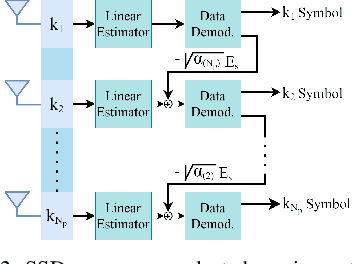


Abstract:Intelligent reflecting surface (IRS) is being considered as a prospective candidate for next-generation wireless communication due to its ability to significantly improve coverage and spectral efficiency by controlling the propagation environment. One of the ways IRS increases spectral efficiency is by adjusting phase shifts to perform passive beamforming. In this letter, we integrate the concept of IRS-aided communication to the domain of multi-direction beamforming, whereby multiple receive antennas are selected to convey more information bits than existing spatial modulation (SM) techniques at any specific time. To complement this system, we also propose a successive signal detection (SSD) technique at the receiver. Numerical results show that the proposed design is able to improve the average successful bits transmitted (ASBT) by the system, which outperforms other state-of-the-art methods proposed in the literature.
Recurrent Neural Network Assisted Transmitter Selection for Secrecy in Cognitive Radio Network
Feb 16, 2021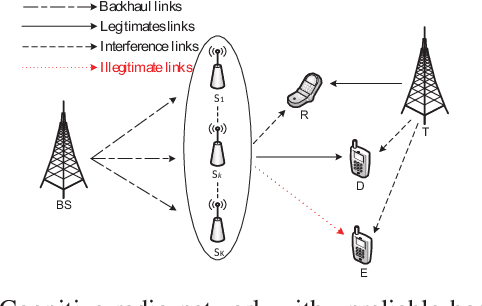
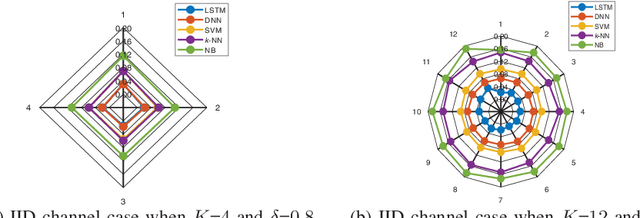
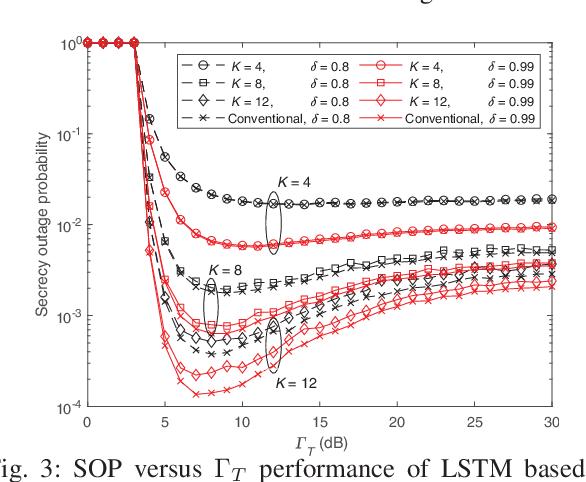
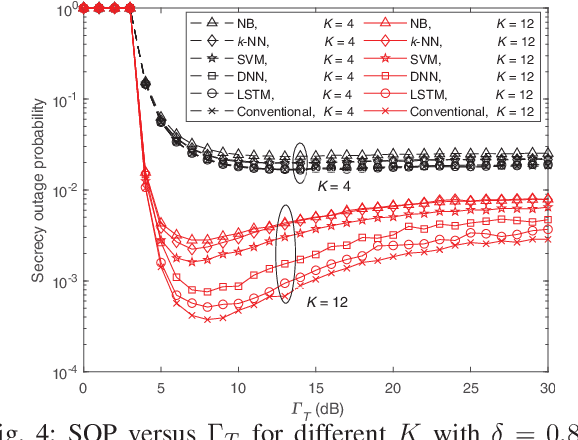
Abstract:In this paper, we apply the long short-term memory (LSTM), an advanced recurrent neural network based machine learning (ML) technique, to the problem of transmitter selection (TS) for secrecy in an underlay small-cell cognitive radio network with unreliable backhaul connections. The cognitive communication scenario under consideration has a secondary small-cell network that shares the same spectrum of the primary network with an agreement to always maintain a desired outage probability constraint in the primary network. Due to the interference from the secondary transmitter common to all primary transmissions, the secrecy rates for the different transmitters are correlated. LSTM exploits this correlation and matches the performance of the conventional technique when the number of transmitters is small. As the number grows, the performance degrades in the same manner as other ML techniques such as support vector machine, $k$-nearest neighbors, naive Bayes, and deep neural network. However, LSTM still significantly outperforms these techniques in misclassification ratio and secrecy outage probability. It also reduces the feedback overhead against conventional TS.
 Add to Chrome
Add to Chrome Add to Firefox
Add to Firefox Add to Edge
Add to Edge